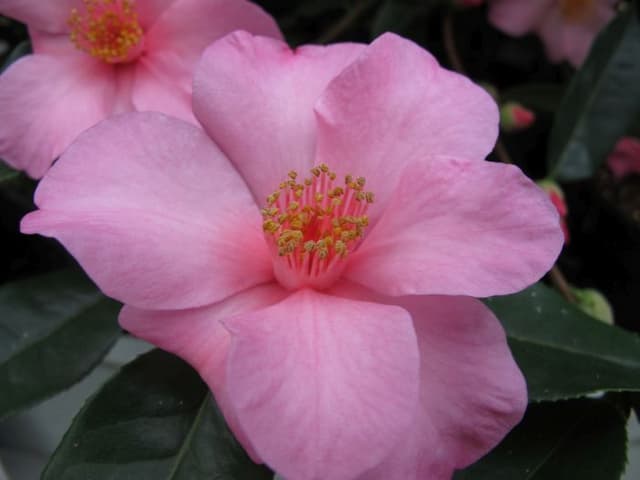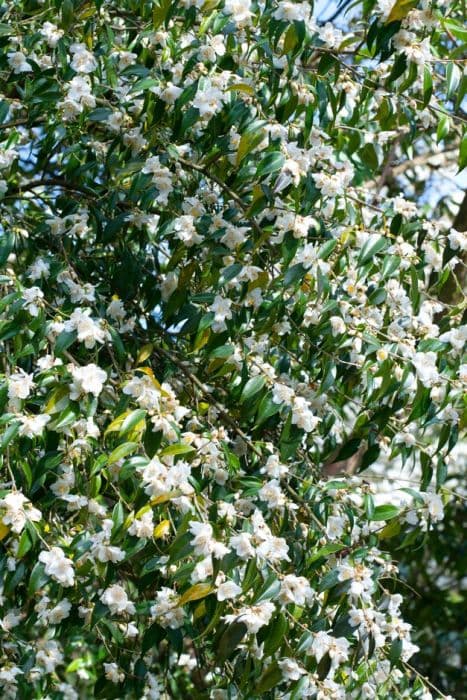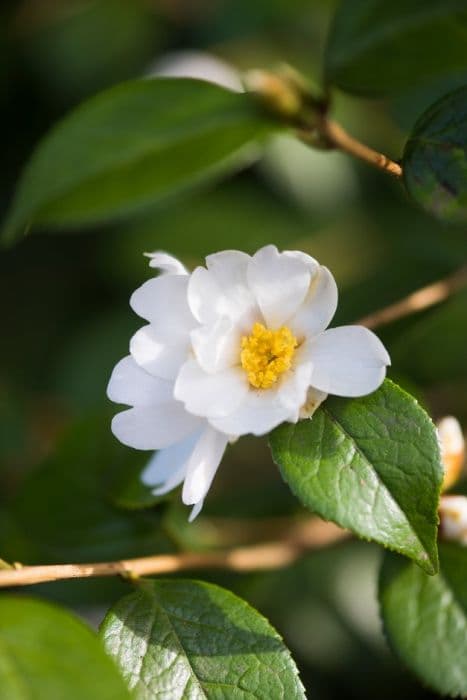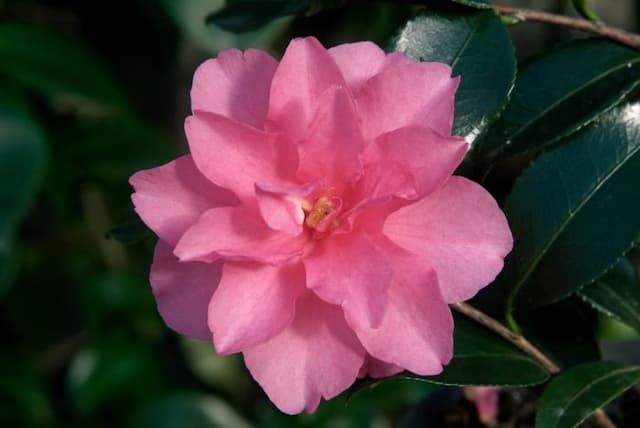Japanese Camellia Camellia japonica 'Comte de Gomer'

ABOUT
The Camellia japonica 'Comte de Gomer' is a visually striking plant known for its luscious, evergreen foliage and spectacular blooms. The glossy leaves are dark green, and they provide a beautiful, year-round backdrop for the flowers. The flowering period of this plant is a true highlight, occurring typically in the late winter to early spring. The flowers of 'Comte de Gomer' are large and showy with a classic, double form that resembles a rose. Petals are ruffled and can come in a range of colors from deep pink to sometimes almost red, depending on the conditions in which the plant is grown, making each plant a bit unique in its floral display. The richly colored blossoms make this cultivar a very popular choice among garden enthusiasts. These elegant flowers are often contrasted with bright yellow stamens in the center, adding to their ornate appearance. They emit a subtle fragrance that can be a delightful addition to the garden ambience during their blooming season. The overall look of the 'Comte de Gomer' is one of classic beauty, with its delightful foliage and captivating flowers contributing to its status as a favorite among ornamental plants.
About this plant
 Names
NamesFamily
Theaceae.
Synonyms
Japanese Camellia, Common Camellia, Japonica.
Common names
Camellia japonica 'Comte de Gomer'.
 Toxicity
ToxicityTo humans
Japanese camellia is considered non-toxic to humans. Therefore, there are no known toxic effects or symptoms from ingesting this plant for humans. However, as with any plant material, individiduals might have allergic reactions or experience gastrointestinal discomfort if large amounts are ingested.
To pets
Japanese camellia is also considered non-toxic to pets. Ingesting parts of this plant should not cause any serious symptoms of poisoning in pets. Nevertheless, some pets may experience mild gastrointestinal upset if they consume a large amount of the plant material.
 Characteristics
CharacteristicsLife cycle
Perennials
Foliage type
Evergreen
Color of leaves
Green
Flower color
Pink
Height
6-10 feet [1.8-3 meters]
Spread
6-10 feet [1.8-3 meters]
Plant type
Shrub
Hardiness zones
7
Native area
Japan
Benefits
 General Benefits
General Benefits- Ornamental Value: The Camellia japonica 'Comte de Gomer' is prized for its large, showy blooms that can add a dramatic splash of color to gardens.
- Evergreen Foliage: As an evergreen shrub, it provides year-round interest with its glossy green leaves.
- Shade Tolerance: This variety is capable of thriving in partial shade, making it suitable for planting under the canopy of larger trees or in shadowed garden spots.
- Low Maintenance: It requires minimal care once established, with only occasional pruning and watering needed.
- Drought Resistance: Once established, it can tolerate periods of dryness, although it prefers consistent moisture.
- Versatility: Suitable for use in a variety of landscaping designs including hedges, borders, and as a standalone specimen.
- Wildlife Attraction: Its flowers can attract pollinators such as bees, providing a boon to the local ecosystem.
- Long Blooming Period: The blooming season spans from late winter to spring, offering a long period of visual interest.
- Cultural Significance: Camellias have a rich history and symbolism, particularly in East Asian cultures, and are often used in traditional garden designs.
- Soil Adaptability: This plant can adapt to a range of soil types, although it prefers well-drained, acidic soils.
 Medical Properties
Medical PropertiesThis plant is not used for medical purposes.
 Air-purifying Qualities
Air-purifying QualitiesThis plant is not specifically known for air purifying qualities.
 Other Uses
Other Uses- Dye Production: The petals of the Camellia can be used to create a natural dye for fabrics, yielding delicate colors often used in traditional crafts.
- Bonsai: Due to its beautiful flowers and glossy leaves, Camellia is favoured for creating bonsai arrangements, adding an aesthetic appeal to desks and small gardens.
- Photography: The Camellia's striking blooms make it a popular subject for botanical photography, capturing the beauty of the flowers in various stages of bloom.
- Wedding Decor: Camellia flowers are sometimes used in wedding bouquets and decorations for their beauty and symbolism of love, admiration, and perfection.
- Art Inspiration: The vibrant blooms of Camellias serve as inspiration for artists, featuring in paintings, illustrations, and textile designs.
- Educational Tool: Being an example of a winter-blooming plant, Camellias can be used as educational specimens to teach about plant biology and seasonal behavior.
- Ink Making: The petals of Camellias, particularly the deep red varieties, have been traditionally used to make plant-based inks for calligraphy and art projects.
- Cosmetics: The oil extracted from Camellia seeds can be used as a component in cosmetics, such as creams and lotions, for its moisturizing properties.
- Culinary Garnish: Though not commonly known for edibility, Camellia petals can serve as a delicate garnish for sophisticated dishes, adding a splash of color.
- Ikebana: In the Japanese art of floral arrangement, Ikebana, Camellia flowers are valued for their form, longevity, and the polished look of their foliage.
Interesting Facts
 Feng Shui
Feng ShuiThe Japanese Camellia is not used in Feng Shui practice.
 Zodiac Sign Compitability
Zodiac Sign CompitabilityThe Japanese Camellia is not used in astrology practice.
 Plant Symbolism
Plant Symbolism- Adoration: Camellias often symbolize deep adoration or admiration, which is why they're commonly given to someone who is revered or loved.
- Perfection: Due to their lush and flawless blooms, camellias represent the ideal, or the perfect beauty.
- Longevity and Gratitude: These plants have a long blooming season and can live for many years, making them symbols of both longevity and gratitude.
- Love and Affection: Different colors of camellias can convey varying messages of love, with red camellias specifically indicating romantic love.
- Refinement: Camellias are often associated with refined beauty because of their elegant blooms; hence they symbolize a person's graceful and well-mannered qualities.
 Water
WaterThe common camellia (Camellia japonica 'Comte de Gomer') should be watered deeply to encourage deep root growth, typically receiving about 1 inch of water per week. This can equate to roughly 0.625 gallons for a small shrub, but the exact amount can vary depending on the size of the plant and the local climate conditions. During the growing season in spring and summer, water the plant thoroughly once a week, ensuring that the soil remains moist but not waterlogged. In the winter, reduce watering but do not let the soil dry out completely; monitor the moisture level and water accordingly. Always water at the base of the plant to avoid wetting the foliage, which can lead to fungal diseases.
 Light
LightThe camellia prefers bright, indirect light or partial shade, making it ideal for an east-facing garden where it can enjoy morning sunlight and avoid the intense afternoon heat. Placing the camellia under the canopy of taller trees can provide the dappled sunlight it thrives in. Direct summer sunlight can be harsh and may harm the delicate blooms and leaves, so it's best to protect the plant from prolonged direct exposure.
 Temperature
TemperatureCamellias enjoy moderate climates and can typically endure temperatures as low as 10 degrees Fahrenheit, though hardy varieties may survive slightly colder conditions. The ideal temperature range for thriving camellias is between 60 and 75 degrees Fahrenheit. Excessive heat can stress these plants, so they should be shielded from the extreme high temperatures that exceed 85 degrees Fahrenheit.
 Pruning
PruningPruning is important for maintaining the health and shape of your camellia. It should be done immediately after the blooming period ends, typically in late winter or early spring, to shape the plant and remove any dead or weak branches. This timing allows for new growth that will produce next year's blooms. Light pruning every year is preferable to maintain a manageable size and an attractive appearance.
 Cleaning
CleaningAs needed
 Soil
SoilThe Japanese Camellia (Camellia japonica 'Comte de Gomer') thrives in well-draining acidic soil with a pH between 5.5 and 6.5. The best soil mix includes equal parts of loamy soil, peat moss, and perlite or pine bark to facilitate aeration and drainage while retaining adequate moisture.
 Repotting
RepottingJapanese Camellias should be repotted every 2-3 years, or when they become root-bound. Spring is the best time to repot, after blooming has finished, ensuring minimal disruption to the growth cycle.
 Humidity & Misting
Humidity & MistingJapanese Camellias prefer high humidity levels; around 40-60% is ideal. If the air is too dry, especially indoors, you may need to use a humidifier or place a water tray near the plant to maintain the humidity.
 Suitable locations
Suitable locationsIndoor
Ensure bright indirect light, keep soil moist, and maintain high humidity.
Outdoor
Plant in partial shade, shelter from strong winds, and mulch well.
Hardiness zone
7-9 USDA
 Life cycle
Life cycleCamellia japonica 'Comte de Gomer', commonly known as Japanese camellia, starts its life cycle when seeds are planted and germinate, developing into seedlings. After a period of growth, these seedlings mature into shrubs with glossy, evergreen leaves and the shrub enters a vegetative stage. The plant then reaches reproductive maturity, typically within a few years, at which point it begins to produce distinctive large, rose-like flowers usually in late winter to early spring. Following pollination, which can occur through self-fertilization or with the help of insects, the flowers develop into dry capsules containing seeds. Once mature, these capsules release seeds, which can give rise to new plants, thereby completing the life cycle. Throughout its life, the Japanese camellia undergoes seasonal growth and dormancy cycles, with active growth in warm months and rest during colder periods.
 Propogation
PropogationPropogation time
Late Winter to Early Spring
Camellia japonica 'Comte de Gomer', commonly known as the Japanese Camellia, is often propagated through semi-hardwood cuttings. This method is widely favored since it maintains the true characteristics of the parent plant. The best time for taking cuttings is in late summer, after the new growth has begun to harden. Cuttings should be around 4 to 6 inches (10 to 15 centimeters) long, including several leaves. It's important to make a clean cut just below a node and remove the lower leaves. The cut end is then dipped into rooting hormone powder to stimulate root growth and planted into a mixture of peat and perlite or a well-draining potting mix. The cuttings must be kept moist and in a well-ventilated environment with indirect sunlight until roots develop, which usually occurs within a few months.









